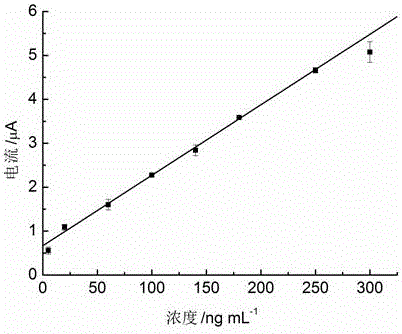Electrochemical method for rapidly detecting fenitrothion pesticide residue
A technology for phosphalt and pesticide residues, applied in the field of biosensing, can solve the problems of strict sample pretreatment requirements, high technical requirements of operators, long detection cycle, etc., and achieves low cost, shortened analysis time, and reproducibility. high effect
- Summary
- Abstract
- Description
- Claims
- Application Information
AI Technical Summary
Problems solved by technology
Method used
Image
Examples
Embodiment Construction
[0034] Below in conjunction with accompanying drawing and embodiment the present invention is described in further detail, and concrete operation method is as follows:
[0035] (1) Preparation of 1% chitosan solution
[0036] Add 0.5 mL of acetic acid to 49.5 mL of secondary water to prepare a 1% acetic acid solution. Take 2 mL of 1% acetic acid solution, add 0.02 g chitosan, and stir ultrasonically until it dissolves to obtain 1% chitosan (W / V), and store it in a refrigerator at 4 °C.
[0037] (2) Synthesis of AuNRs / CS mixture
[0038] The AuNRs solution and 1% chitosan solution were mixed, sonicated for 30 min to make them evenly mixed, and stored in a refrigerator at 4 °C.
[0039] The AuNRs solution in step (2) has an aspect ratio of 3.4 and a concentration of 185.13 μg mL -1 .
[0040] The volume ratio of AuNRs solution and 1% chitosan solution in step (2) is 5:1.
[0041] (3) Working electrode pretreatment
[0042] The bare glassy carbon electrode was repeatedly po...
PUM
 Login to View More
Login to View More Abstract
Description
Claims
Application Information
 Login to View More
Login to View More - R&D
- Intellectual Property
- Life Sciences
- Materials
- Tech Scout
- Unparalleled Data Quality
- Higher Quality Content
- 60% Fewer Hallucinations
Browse by: Latest US Patents, China's latest patents, Technical Efficacy Thesaurus, Application Domain, Technology Topic, Popular Technical Reports.
© 2025 PatSnap. All rights reserved.Legal|Privacy policy|Modern Slavery Act Transparency Statement|Sitemap|About US| Contact US: help@patsnap.com


